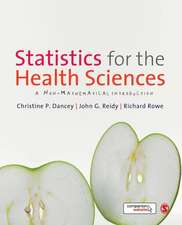Knowledge Engineering in Health Informatics: Computers and Medicine
Autor Homer R. Warner, Dean K. Sorenson, Omar Bouhaddouen Limba Engleză Paperback – 16 mai 2013
| Toate formatele și edițiile | Preț | Express |
|---|---|---|
| Paperback (1) | 1093.72 lei 6-8 săpt. | |
| Springer – 16 mai 2013 | 1093.72 lei 6-8 săpt. | |
| Hardback (1) | 1101.94 lei 6-8 săpt. | |
| Springer – 10 iul 1997 | 1101.94 lei 6-8 săpt. |
Preț: 1093.72 lei
Preț vechi: 1151.28 lei
-5% Nou
Puncte Express: 1641
Preț estimativ în valută:
209.28€ • 219.09$ • 173.17£
209.28€ • 219.09$ • 173.17£
Carte tipărită la comandă
Livrare economică 05-19 aprilie
Preluare comenzi: 021 569.72.76
Specificații
ISBN-13: 9781461272991
ISBN-10: 1461272998
Pagini: 284
Ilustrații: XVI, 265 p.
Dimensiuni: 155 x 235 x 15 mm
Greutate: 0.4 kg
Ediția:Softcover reprint of the original 1st ed. 1997
Editura: Springer
Colecția Springer
Seria Computers and Medicine
Locul publicării:New York, NY, United States
ISBN-10: 1461272998
Pagini: 284
Ilustrații: XVI, 265 p.
Dimensiuni: 155 x 235 x 15 mm
Greutate: 0.4 kg
Ediția:Softcover reprint of the original 1st ed. 1997
Editura: Springer
Colecția Springer
Seria Computers and Medicine
Locul publicării:New York, NY, United States
Public țintă
ResearchCuprins
1 Background and Legacy.- Overview.- Knowledge Representation and Computation Methodologies.- 2 The Expert System Model.- to Modeling.- Choosing a System to Model.- Choosing a Model.- 3 Iliad: The Model Used for This Text.- The Frame Concept.- The Probabilistic Model: Dealing with Uncertainty.- Probabilistic Information.- Heuristics That Improve the Model.- 4 The Data Dictionary: Limiting the Domain of the Model.- Organization of the Dictionary.- Context Versus Concept.- Hierarchical Relationships.- Granularity of the Dictionary.- Modifying the Dictionary.- Knowledge Contained in the Dictionary.- Inferencing from the Hierarchy.- Word Relations.- Data Relations.- 5 The Knowledge Engineering Process.- How to Structure/Model the Knowledge.- The Overall Process.- Knowledge Sources: Advantages and Limitations of Each.- Which Findings to Include in a Frame.- Probabilistic and Deterministic Logic.- Reasons to Cluster.- Types of Clusters.- Frames That Return a Value.- Estimating Probabilities.- Testing Frames in Isolation.- Sources of Error.- Tools to Facilitate the Knowledge Engineering Process.- Combining Frames into a Working System.- 6 Evaluation of the Model.- Testing and Refining the Compiled Knowledge.- Appropriateness of Decisions Based on Data Entered by Experts.- Testing with Data Newly Entered from Patient Charts.- Testing with Cases Stored Earlier.- Modifying Source Frames As Required: The Iterative Process.- 7 Applications of the Model.- Modes of Use.- The User Interface.- Minimal Diagnosis.- Bayes Calculator.- Interfaces to Other Knowledge.- Compromises.- 8 Lessons Learned.- Teaching Medical Clerks, Physician Assistants, and Other Trainees.- As a Tool for Preauthorization.- As a Screening Tool for Quality Improvement.- Commercial Users of Iliad.- 9 Knowledge Engineering Tools.- Knowledge Acquisition.- Structuring and Coding the Knowledge.- Testing the Knowledge Base.- Summary.- 10 Example Knowledge Bases.- The Knowledge Engineering Class.- Medical and Pediatric HouseCall.- Symptom Analysis.- Deriving HouseCall from Iliad.- Knowledge Engineering for HouseCall.- 11 Future Challenges.- Links to Patient Data: Client Server/Version of Iliad.- Future Directions.- References.- Appendices.- 1 Example Hierarchies of Top-Level Diseases (Final Diagnoses) in Various Medical Specialties.- 2 Approximate Estimated Prevalences for Selected Top-Level Diseases in a Family Practice Setting, Categorized by Specialty.- 3 Using the Iliad KE Tool.- 4 Some Example “Domain-Specific” Symptom Lists.- 5 Example Data Relations.- 6 Example Word Relations.



















